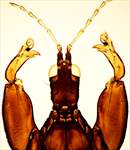
pastinus female

pulchra female

pastinus head & thorax

metopus head & pronotum

pulchra head & pronotum

semifuscipennis subgenital plate

pastinus subgenital plate

magnificus subgenital plate

curvatus prosternites

pulchra domicile on A. harpophylla

Opened pulchra domicile
Generic diagnosis
Large macropterous Phlaeothripinae that create domiciles in which to breed by glueing together pairs of Acacia phyllodes. Head usually widest across eyes; maxillary stylets usually low in head and wide apart; postoccipital ridge usually deeply cleft between two large posteriorly pointing tubercles. Antennae 8-segmented, III with one sense cone, IV with 3 sense cones, these sense cones unusually short. Pronotum commonly elongate, setae unusually short; notopleural sutures complete. Prosternal basantra usually present but small and transverse; ferna commonly elongate and large; metathoracic sterno-pleural sutures moderately long. Mesonotum with short narrow cleft posteromedially, lateral setae not elongate. Metanotal median area weakly reticulate or without sculpture, median setae weak. Fore tarsal tooth long and pointed. Fore wings unusually broad, terminal cilia short, usually with numerous duplicated cilia; sub-basal setae short. Pelta usually almost square; lateral margins of tergites with group of small setae arising from flattened tubercle; tergal wing-retaining setae slender and curved, scarcely sigmoid, those on VII small and straight; tergal antecostal ridge deeply curved, commonly with median longitudinal ridge; tube relatively slender and shorter than head, anal setae relatively short; sternal marginal setae arising far apart, S2 commonly short and arising on a tubercle; female subgenital plate unusually large, often with serrate margin; fustis sometimes broad not rod-like. Male smaller than female, sternite VIII with pore plate; tergite IX setae S2 as long as setae S1.
Nomenclatural data
Lichanothrips Mound, 1971: 434. Type species Lichanothrips albus Mound, 1971, by original designation.
There are 10 species described in this genus.
Australian species
Lichanothrips albus Mound, 1971: 437
Lichanothrips calcis Crespi, Morris & Mound, 2004: 260
Lichanothrips curvatus Crespi, Morris & Mound, 2004: 261
Lichanothrips magnificus Mound, 1971: 437
Lichanothrips metopus Crespi, Morris & Mound, 2004: 262
Lichanothrips pastinus Crespi, Morris & Mound, 2004: 263
Lichanothrips pulchra (Girault, 1927: 2)
Lichanothrips semifuscipennis (Girault, 1926: 1)
Lichanothrips triquetus Crespi, Morris & Mound, 2004: 266
Lichanothrips xouthus Crespi, Morris & Mound, 2004: 266
Relationship data
Relationships of this distinctive genus within the Phlaeothripinae are not clear, but it is probably related to one or more of the other genera with species that create domiciles on Acacia phyllodes.
Distribution data
Known only from Australia, the species of this genus have been taken mainly in Queensland but also in central Australia in semi-arid areas.
Biological data
All species in this genus glue together pairs of Acacia phyllodes to create a nest or domicile within which they breed.
References
Crespi BJ, Morris DC & Mound LA (2004) Evolution of ecological and behavioural diversity: Australian Acacia thrips as model organisms. Australian Biological Resources Study & Australian National Insect Collection, CSIRO, Canberra, Australia, pp. 1–328.